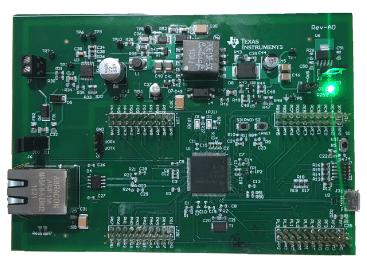This versatile and integrated solution facilitates the development of connected, intelligent devices, contributing to the advancement of IoT technology in multiple sectors.

Power Over Ethernet (PoE) is a transformative technology for industrial gateways, offering significant advantages in terms of efficiency, cost-effectiveness, and reliability. By integrating data and power transmission over a single Ethernet cable, PoE simplifies installation and reduces the need for additional electrical infrastructure, making it particularly valuable in industrial environments. This streamlined approach not only minimizes wiring complexity and associated costs but also enhances flexibility in device placement, ensuring optimal network design and scalability.
This reference design TIDM-1018 by Texas Instruments, seamlessly integrates the company’s Power over Ethernet (PoE) technology with the high-performance SimpleLink MSP432E4 Ethernet microcontroller (MCU), enabling customers to develop robust applications for the Internet of Things (IoT) on a compact board. By combining the ability to derive power from existing network cabling with advanced data processing and cloud communication capabilities, this design significantly enhances the value of end applications.This reference design has varied applications, including HVAC gateways, HVAC system controllers, security gateways, and condition monitoring gateways.
The design features a small form factor board measuring 4.95 inches by 3.45 inches, equipped with the MSP432E401Y MCU, which includes an integrated Ethernet PHY and MAC. This integration provides a cost-effective bill of materials (BOM) with an onboard RJ45 connector, transformer, and diode bridge for the PoE power stage. The board also includes a 7-W isolated output from a fly-back converter, with provisions for both 5-V and 3.3-V output power rails, ensuring flexible power supply options. It offers an optional power header to supply external DC power from an uninterruptible power supply (UPS) in case of network power failure. To facilitate rapid prototyping and development, the board features dual BoosterPack™ plug-in module headers, compatible with a wide range of BoosterPacks from TI and third-party vendors. Developers can leverage the SimpleLink MSP432E4 Software Development Kit (SDK), with examples that can be run without modifications for evaluation purposes.
The MSP432E401Y is a 120-MHz high-performance MCU boasting 1MB of on-chip flash and 256KB of on-chip SRAM. It also includes an integrated Ethernet MAC + PHY for connected applications and features cryptographic modules for AES, DES, and SHA, supporting encryption, decryption, and authentication. The TPS23753A combines a PoE powered device (PD) interface with a current-mode DC-DC controller, optimized for isolated converter designs. This implementation supports the IEEE 802.3at standard as a 13-W, type 1 PD. The TPD2E2U06 is a dual-channel, low-capacitance TVS diode designed for ESD protection, offering ±25-kV contact and ±30-kV air-gap ESD protection per the IEC 61000-4-2 standard. Furthermore, the TLV431 device is a low-voltage, 3-terminal adjustable voltage reference with specified thermal stability over industrial and commercial temperature ranges. Its output voltage can be adjusted between VREF (1.24 V) and 6 V using two external resistors, operating from a lower voltage than the commonly used TL431 and TL1431 shunt-regulator references.
TI has tested this reference design. It comes with a bill of materials (BOM), schematics, assembly drawing, printed circuit board (PCB) layout, etc. You can find additional data about the reference design on the company’s website. To read more about this reference design, click here.








